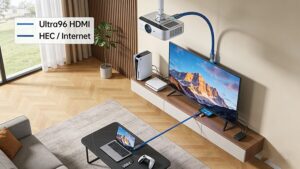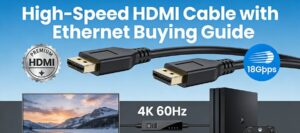Introducción
USB-C a HDMI hace referencia a un tipo de cable o adaptador que conecta un dispositivo con un puerto USB-C (como un portátil, un smartphone o una tableta) a una pantalla o televisor con una entrada HDMI. Esta conexión permite la transmisión de señales de audio y vídeo desde el dispositivo USB-C a la pantalla equipada con HDMI.
El uso de un cable o adaptador USB-C a HDMI permite que los dispositivos con puertos USB-C se conecten fácilmente a pantallas HDMI, lo que admite una salida de audio y vídeo de alta calidad y resulta muy práctico para presentaciones, juegos o transmisión multimedia.
Mitos comunes sobre USB-C a HDMI
Mito 1: USB-C a HDMI admite todas las resoluciones - Explicación de la resolución admitida y sus limitaciones.
Soporte y limitaciones La creencia de que un adaptador o cable USB-C a HDMI puede soportar todas las resoluciones es un error común.
Aunque USB-C es un conector versátil y potente, su capacidad para transmitir varias resoluciones de vídeo a través de HDMI depende de varios factores:
1. Versión del modo alternativo USB-C/DisplayPort:
- No todos los puertos USB-C admiten el modo alternativo DisplayPort, necesario para la salida de vídeo. La tecnología específica utilizada en el estándar USB-C determina la resolución máxima y la frecuencia de actualización.
Por ejemplo:
- Los puertos USB-C compatibles con DisplayPort 1.2 suelen soportar hasta 4K a 60H.
- Los puertos USB-C con DisplayPort 1.4 pueden admitir 8K a 60 Hz, siempre que el dispositivo y el adaptador/cable también lo admitan.
2. Calidad del adaptador/cable:
- La calidad y las especificaciones del adaptador/cable USB-C a HDMI desempeñan un papel fundamental en la resolución. Los adaptadores más baratos o mal fabricados pueden no cumplir las normas necesarias y limitar la resolución y la frecuencia de actualización. Busque siempre adaptadores certificados que especifiquen las resoluciones máximas admitidas.
3. Versión HDMI:
- La versión HDMI compatible con el adaptador o el cable también influye en las capacidades de resolución.
Por ejemplo:
- 1.4 admite hasta 4K a 30 Hz.
- 2.0 permite 4K a 60 Hz.
- 2.1 es necesario para 8K a 60 Hz o 4K a 120 Hz.
4. Compatibilidad de dispositivos:
- Tanto el dispositivo de origen (portátil, tableta, etc.) como la pantalla (monitor, televisor, etc.) deben ser capaces de soportar resoluciones superiores. Si uno de los dispositivos está limitado a 1080p, esa será la resolución máxima independientemente de lo que pueda soportar el adaptador.
5. Sistema operativo y controladores:
- A veces, las configuraciones del sistema operativo o los controladores obsoletos pueden afectar a la configuración de la resolución. Asegurarse de que el sistema está actualizado puede ayudar a mejorar la compatibilidad con las distintas resoluciones de salida.
6. Impacto de la tasa de refresco:
- La frecuencia de refresco a veces puede verse limitada cuando se utilizan resoluciones más altas. Por ejemplo, aunque consigas una resolución 4K, es posible que solo obtengas una frecuencia de refresco de 30 Hz, lo que podría afectar a tu experiencia de visualización, especialmente en juegos o contenidos de movimiento rápido.
Mito 2: Todos los puertos USB-C pueden emitir HDMI - Aclaramos qué puertos USB-C tienen esta capacidad
De hecho, es un error común pensar que todos los puertos USB-C pueden emitir señales HDMI. En realidad, no todos los puertos USB-C admiten salida de vídeo. La capacidad depende en gran medida de las especificaciones de la implementación USB-C del fabricante. Aquí tienes un desglose de los puertos USB-C que pueden emitir señales HDMI y otras señales de vídeo:
1. Modo alternativo USB-C:
- Modo alternativo DisplayPort (DP Alt Mode):Muchos puertos USB-C admiten la salida de vídeo a través del modo alternativo DisplayPort. Si un puerto USB-C tiene esta capacidad, puede transmitir una señal de vídeo a un adaptador o cable HDMI.
- Thunderbolt 3/4: Estos puertos también admiten salida de vídeo y suelen incluir funciones DisplayPort. Pueden conectarse a pantallas HDMI utilizando el adaptador adecuado.
2. Adaptadores USB-C a HDMI:
- Si el puerto USB-C admite el modo DP Alt o es un puerto Thunderbolt, puedes utilizar un adaptador o cable USB-C a HDMI para conectarlo a una pantalla HDMI.
3. USB-C Power Delivery:
- Aunque USB-C puede suministrar energía (carga de dispositivos), esto no implica que tenga capacidad de salida de vídeo. Un puerto puede ser capaz de cargar pero no de transmitir vídeo.
4. Identificar los puertos USB-C adecuados:
- Consulta las especificaciones del dispositivo:La forma más sencilla de determinar si un puerto USB-C admite salida de vídeo es consultar el manual de usuario o las especificaciones técnicas del dispositivo.
- Logo USB-C:Algunos dispositivos marcan claramente los puertos USB-C que admiten vídeo con iconos que indican DisplayPort o Thunderbolt.
5. Limitaciones:
- Que un puerto sea USB-C no significa intrínsecamente que admita vídeo. Los dispositivos de bajo coste o más antiguos pueden incluir USB-C sin soportar las capacidades de salida de vídeo.
Conclusiones: No todos los puertos USB-C pueden emitir señales HDMI. Para garantizar la compatibilidad, es importante comprobar las capacidades específicas del puerto USB-C, buscar compatibilidad con DP Alt Mode o Thunderbolt y consultar la documentación del producto o los recursos del fabricante.
Mito 3: Los cables USB-C a HDMI son iguales que los cables USB-C - Diferencias entre los tipos de cables USB-C disponibles.
Este mito no es cierto. Aunque los cables USB-C a HDMI y los cables USB-C normales pueden parecer similares, tienen funciones y capacidades diferentes.
Los cables USB-C a HDMI están diseñados específicamente para transmitir señales de audio y vídeo desde un dispositivo USB-C (como un portátil o un smartphone) a una pantalla o televisor con entrada HDMI. Estos cables suelen admitir resoluciones de vídeo de alta definición y salida de audio, lo que los hace adecuados para conectar dispositivos para presentaciones, ver películas o jugar.
Por otro lado, los cables USB-C normales son más versátiles y pueden utilizarse para diversos fines, como cargar dispositivos, transferir datos o conectar periféricos como teclados y ratones. Estos cables pueden no tener el hardware necesario para transmitir señales de audio y vídeo, por lo que no son adecuados para conectarse a pantallas HDMI. Es importante tener en cuenta que no todos los cables USB-C son iguales, y algunos pueden no ser capaces de soportar la transferencia de datos a alta velocidad o la carga rápida.
Al comprar un cable USB-C, asegúrate de comprobar la compatibilidad con tus dispositivos específicos y el uso previsto para garantizar un rendimiento óptimo.
Qué puede hacer USB-C a HDMI
Salida de vídeo de alta definición
Los adaptadores y cables USB-C a HDMI están diseñados para conectar dispositivos con un puerto USB-C (como portátiles, smartphones y tabletas) a una pantalla con HDMI (como monitores, televisores y proyectores).
- Apoyo a la resolución: La mayoría de los adaptadores USB-C a HDMI admiten resoluciones de alta definición, como: - 1080p (Full HD) - 4K (Ultra HD) hasta 60Hz o 30Hz, dependiendo del adaptador y de las capacidades de los dispositivos implicados.
- Alto rango dinámico (HDR): Algunos adaptadores pueden transmitir contenidos HDR, mejorando el color y el contraste para obtener una imagen más vibrante.
- Transporte de flujos múltiples (MST): Algunos adaptadores admiten MST, lo que permite conectar varias pantallas utilizando un único puerto USB-C, aunque esto es más común en conexiones DisplayPort.
Capacidad de transmisión de audio
Un cable o adaptador USB-C a HDMI puede transportar señales de audio junto con señales de vídeo, lo que le permite transmitir audio de alta calidad desde su dispositivo a un monitor o televisor. Las capacidades de transmisión de audio de USB-C a HDMI son importantes porque determinan qué formatos de audio puede admitir la conexión.
Los formatos de audio más comunes compatibles con USB-C a HDMI incluyen:
- Audio estéreo: Este formato consta de dos canales de audio, normalmente destinados a los altavoces izquierdo y derecho. Ofrece una calidad de audio básica pero suficiente para la mayoría de usuarios ocasionales.
- Sonido envolvente 5.1: Este formato utiliza seis canales de audio, lo que ofrece una experiencia de audio más envolvente con un sonido distinto procedente de distintas direcciones. Se suele utilizar en sistemas de cine en casa y en juegos.
- Sonido envolvente 7.1: Este formato amplía el sonido envolvente 5.1 añadiendo dos canales de audio adicionales para una reproducción de audio aún más detallada y envolvente. Proporciona una experiencia de audio más realista, especialmente en películas y juegos.
- Dolby Atmos: Este formato de audio lleva el sonido envolvente al siguiente nivel al permitir que los sonidos se muevan en el espacio 3D, creando una experiencia de audio más envolvente y realista. Dolby Atmos se utiliza habitualmente en sistemas de cine en casa y cines de gama alta.
En general, las capacidades de transmisión de audio de USB-C a HDMI le permiten disfrutar de una reproducción de audio de alta calidad desde su dispositivo a una pantalla externa o sistema de audio. Antes de comprar un cable o adaptador USB-C a HDMI, asegúrate de que es compatible con el formato de audio que prefieras para garantizar una experiencia audiovisual perfecta.
Configuraciones multimonitor
USB-C a HDMI y configuraciones multimonitor Los adaptadores y cables USB-C a HDMI son cada vez más populares para conectar dispositivos a pantallas externas. Ofrecen una serie de funcionalidades que pueden mejorar enormemente la productividad, especialmente en configuraciones multimonitor.
Aquí tienes un resumen de cómo USB-C a HDMI puede facilitar estas configuraciones:
- Compatibilidad de dispositivos:Los puertos USB-C se encuentran en una amplia variedad de dispositivos, como portátiles, tabletas y smartphones. Muchos de estos dispositivos admiten la salida de vídeo a través del puerto USB-C mediante el modo alternativo DisplayPort. Esto significa que puedes conectar tu dispositivo sin problemas a monitores HDMI sin necesidad de conectores de salida de vídeo adicionales.
- Compatible con varias pantallasMuchos adaptadores de USB-C a HDMI admiten varias salidas de pantalla. Dependiendo del adaptador, puede conectar varios monitores HDMI. Algunos adaptadores tienen varios puertos HDMI, mientras que otros admiten la conexión en cadena a través de DisplayPort, lo que permite ampliar el espacio de pantalla y las capacidades multitarea.
- Resolución y frecuencia de actualización:USB-C a HDMI admite altas resoluciones y frecuencias de actualización. Dependiendo de la versión de HDMI (por ejemplo, HDMI 2.0 o 2.1), puede alcanzar resoluciones 4K de hasta 60 Hz o incluso frecuencias de actualización superiores para juegos en monitores compatibles. Esto garantiza imágenes nítidas y un rendimiento fluido en varias pantallas.
- Mirroring y pantallas ampliadasPuede utilizar una conexión USB-C a HDMI para reflejar su pantalla principal (mostrando el mismo contenido) o ampliar su escritorio a varias pantallas. Esto es especialmente beneficioso para la productividad, ya que permite tener varias aplicaciones abiertas y visibles simultáneamente.
Conclusión La funcionalidad USB-C a HDMI ofrece una solución flexible y potente para configuraciones multimonitor. Permite a los usuarios ampliar su espacio de trabajo, mejorar la productividad y disfrutar de experiencias audiovisuales de alta calidad. A medida que más dispositivos adopten la tecnología USB-C, la capacidad de crear configuraciones multimonitor eficientes seguirá creciendo, ofreciendo nuevas posibilidades tanto para el trabajo como para el entretenimiento.
Lo que USB-C a HDMI no puede hacer
- Dispositivos con capacidad de salida de vídeo limitada: Es posible que algunos dispositivos, como smartphones y tabletas, no admitan la salida HDMI a través de USB-C debido a limitaciones de hardware. Esto podría deberse al procesador, la tarjeta gráfica o los ajustes de salida de vídeo del dispositivo.
- Dispositivos antiguos: Es posible que los portátiles, ordenadores de sobremesa o dispositivos móviles más antiguos no tengan puertos USB-C o no admitan la salida de vídeo a través de USB-C. En este caso, los usuarios tendrían que utilizar métodos alternativos, como un adaptador de USB-C a HDMI o un puerto de salida de vídeo diferente.
- Dispositivos con capacidades USB-C limitadas: Algunos dispositivos pueden tener puertos USB-C que no admiten salida de vídeo, ya sea por limitaciones de hardware o restricciones de firmware. En estos casos, los usuarios no podrán utilizar un adaptador USB-C a HDMI para la salida de vídeo.
- Dispositivos con capacidad limitada de suministro de energía: Es posible que algunos dispositivos no admitan la funcionalidad de USB-C a HDMI si no proporcionan suficiente alimentación a través del puerto USB-C para admitir tanto la salida de vídeo como la carga. En este caso, es posible que los usuarios tengan que utilizar una fuente de alimentación independiente para la pantalla HDMI.
- Resoluciones o frecuencias de actualización no compatibles: Es posible que algunos dispositivos no admitan determinadas resoluciones o frecuencias de actualización a través de USB-C a HDMI, lo que puede provocar problemas de compatibilidad o una calidad de vídeo deficiente. Los usuarios deben comprobar las especificaciones de sus dispositivos y los requisitos de visualización HDMI antes de utilizar un adaptador USB-C a HDMI.
PREGUNTAS FRECUENTES
1.¿Puedo utilizar un adaptador de USB-C a HDMI con mi portátil?
Sí, puedes utilizar un adaptador de USB-C a HDMI siempre que tu portátil admita salida de vídeo USB-C.
2.¿Hay alguna diferencia entre USB-C y USB-C Thunderbolt?
Sí, hay una diferencia entre USB-C y USB-C Thunderbolt. USB-C es un estándar de interfaz física que puede utilizarse para conectar diversos dispositivos, como teléfonos móviles, tabletas y ordenadores. USB-C Thunderbolt es un estándar que añade la tecnología Thunderbolt a la interfaz USB-C, que puede proporcionar velocidades de transferencia de datos más rápidas y más funciones. Thunderbolt admite mayores velocidades de transferencia de datos y más opciones de conexión de periféricos.
3.¿Qué dispositivos admiten normalmente USB-C a HDMI?
Los dispositivos que normalmente admiten USB-C a HDMI incluyen: 1. Portátiles (por ejemplo, MacBook, Dell XPS) 2. Smartphones (por ejemplo, algunos modelos Android) 3. Tablets (por ejemplo, iPad Pro) 4. Monitores con entradas USB-C Monitores con entradas USB-C 5. Algunas consolas de videojuegos y dispositivos de streaming.






